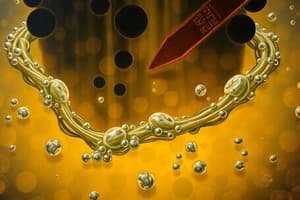Podcast
Questions and Answers
What forms the hydrophobic core in a phospholipid bilayer?
What forms the hydrophobic core in a phospholipid bilayer?
- Integral proteins
- Cholesterol molecules
- Long fatty acyl side chains (correct)
- Polar head groups
Cholesterol increases the rigidity of phospholipid bilayers.
Cholesterol increases the rigidity of phospholipid bilayers.
False (B)
What role do proteins in the plasma membrane play in cellular function?
What role do proteins in the plasma membrane play in cellular function?
They selectively absorb nutrients, expel wastes, and maintain intracellular ionic composition.
The presence of glycolipids contributes to membrane __________.
The presence of glycolipids contributes to membrane __________.
Match the following components with their functions:
Match the following components with their functions:
What is the effect of heating on a phospholipid bilayer?
What is the effect of heating on a phospholipid bilayer?
All cellular membranes possess a cytosolic face and an extracellular matrix.
All cellular membranes possess a cytosolic face and an extracellular matrix.
What primarily gives plant cells their shape and rigidity?
What primarily gives plant cells their shape and rigidity?
Flashcards
Phospholipid bilayer
Phospholipid bilayer
A membrane structure with hydrophobic cores and polar head groups on surfaces.
Membrane asymmetry
Membrane asymmetry
The uneven distribution of proteins and lipids in the bilayer faces.
Fluid mosaic model
Fluid mosaic model
Describes the cell membrane as a fluid and flexible layer of lipids and proteins.
Cholesterol's role
Cholesterol's role
Signup and view all the flashcards
Integral proteins
Integral proteins
Signup and view all the flashcards
Cytosolic vs Exoplasmic face
Cytosolic vs Exoplasmic face
Signup and view all the flashcards
Cell wall in plants
Cell wall in plants
Signup and view all the flashcards
Extracellular matrix
Extracellular matrix
Signup and view all the flashcards
Study Notes
Phospholipid Bilayer Structure
- Phospholipid bilayers have acyl chains oriented inward, creating a hydrophobic core and polar heads facing outward.
- This structure forms the basis of all biomembranes.
Biomembrane Composition and Function
- Biomembranes contain phospholipids, proteins (integral and peripheral), glycoproteins, cholesterol, and glycolipids.
- Different membranes have unique protein compositions, enabling diverse functions.
- Membranes enclose compartments with distinct cytosolic and exoplasmic faces.
- Membrane asymmetry arises from the specific orientation of integral and peripheral proteins, and the exclusive presence of glycolipids on the exoplasmic face.
Membrane Fluidity and Dynamics
- Membrane components (proteins and lipids) are largely mobile within the bilayer.
- The fluid mosaic model depicts membranes as a dynamic mosaic of lipids and proteins.
- Bilayer fluidity is temperature-dependent, transitioning from gel-like to fluid states over a specific temperature range.
- Cholesterol significantly affects fluidity, with its impact varying by membrane composition.
- Cells regulate phospholipid composition to maintain optimal fluidity.
Membrane Protein Functions
- Plasma membrane proteins are vital for nutrient uptake, waste expulsion, and ion homeostasis.
- Plasma membrane proteins link membranes to the cytoskeleton and extracellular matrix/cell wall.
- Cell-to-cell communication in multicellular organisms occurs via specialized plasma membrane proteins.
Plant Cell Walls
- Plant cell walls, primarily composed of cellulose, define cell shape and provide rigidity.
- Animal cells lack cell walls but have an extracellular matrix composed of collagen and glycoproteins.
Studying That Suits You
Use AI to generate personalized quizzes and flashcards to suit your learning preferences.




